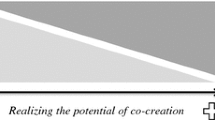Abstract
Through a case study approach, this article explores how non-profits can effectively participate in joint ventures with larger, for-profit institutions. In addition to offering a new product or service, these partnerships should build the brands of both organizations. The similarity between for-profit business joint ventures and non-profit joint ventures is examined. The author compares two non-profit joint ventures – one successful and one unsuccessful – to demonstrate the importance of several aspects of joint ventures. Just as in business ventures, non-profits must carefully select their partners, have a clear understanding of roles and responsibilities, engage in open communication, and have a written charter of each partner's roles and responsibilities. Most importantly, non-profits must ensure that they are treated as equal partners and that their brand is reinforced in any communication to their stakeholders.
Similar content being viewed by others
Notes
Several authors have discussed what make joint ventures or strategic alliances successful. Among them are Kilburn, 1999, Hook, 2004, Arino and Reuer, 2004, Elmuti and Kathawala, 2001 and Lorange et al, 1992. Note that strategic alliances are similar to JVs, although they tend to be temporary relationships for a shorter period of time. They also tend to be less complex than JVs.
References
American Hospital Association. (2009) Fast facts on US hospitals, http://www.aha.org/research/rc/stat-studies/fast-facts.shtml, accessed 1 March 2012.
Arino, A. and Reuer, J. (2004) Designing and renegotiating strategic alliance contracts. Academy of Management Executive 8 (3): 37–48.
Bamford, J.E.D. and Fubini, D.G. (2004) Launching a world-class joint venture. Harvard Business Review 82 (2): 90–100.
Blackwood, A., Wing, K.T. and Pollak, T.H. (2008) The non-profit sector in brief. National Center for Charitable Statistics at the Urban Institute, http://nccsdataweb.urban.org/kbfiles/797/Almanac2008publicCharities.pdf, accessed 1 March 2012.
Bovaird, T. (2004) Public-private partnerships: From contested concepts to prevalent practice. International Review of Administrative Sciences 70 (2): 199–215.
Buchel, B. (2003) Managing partner relations in joint ventures. MIT Sloan Management Review 44 (4): 91.
Buono, A.F. (1991) Managing strategic alliances: Organizational and human resource considerations. Business in the Contemporary World 3 (4): 92–101.
Crovitz, L.G. (2004) Crafting a JV prenup. Harvard Business Review 82 (11): 30–32.
Dyer, J., Kale, P. and Singh, H. (2001) How to make strategic alliances work. MIT Sloan Management Review 42 (4): 37–43.
Elmuti, D. and Kathawala, Y. (2001) An overview of strategic alliances. Management Decision 39 (3): 205–217.
Googins, B.K. and Rochlin, S.A. (2000) Creating the partnership society: Understanding the rhetoric and reality of cross-sectoral partnerships. Business and Society Review 105 (1): 127–144.
Gulati, R., Khanna, T. and Nohria, N. (1994) Unilateral commitments and the importance of process in alliances. MIT Sloan Management Review 35 (3): 61.
Hill, R.C. and Hellriegel, D. (1994) Critical contingencies in joint venture management: Some lessons from managers. Organization Science 5 (4): 594–607.
Hoffmann, W.H. and Schlosser, R. (2001) Success factors of strategic alliances in small and medium-sized enterprises: An empirical survey. Long Range Planning 34 (3): 57–81.
Hook, L. (2004) Successful strategic alliances, what makes them work. AIPMM Newsletter. 28 September, http://www.aipmm.com/html/newsletter/archives/000060.php, accessed 1 March 2012.
Huxham, C. and Vangen, S. (1996) Working together: Key themes in the management of relationships between public and non-profit organizations. International Journal of Public Sector Management 9 (7): 5–17.
Kilburn, D. (1999) Partnership in cultural turmoil. Marketing Week 38 (15): 20–23.
Lafferty, B.A. and Goldsmith, R.E. (2005) Cause-brand alliances: Does the cause help the brand or does the brand help the cause? Journal of Business Research 58 (4): 423–429.
Lorange, P., Ross, J. and Bronn, P.S. (1992) Building successful strategic alliances. Long Range Planning 25 (6): 10–17.
Nan, X. and Heo, K. (2007) Consumer response to corporate social responsibility (CSR) initiatives: Examining the role of brand-cause fit in cause related marketing. Journal of Advertising 36 (2): 63–74.
Nishtar, S. (2004) Public-private ‘partnerships’ in health – A global call to action. Health Research Policy and Systems 2, article 5.
Pracejus, J.W. and Olsen, G.D. (2004) The role of brand/cause fit in the effectiveness of cause-related marketing campaigns. Journal of Business Research 57 (6): 635–640.
Roberts, M.J., Breitenstein, A.G. and Roberts, C.S. (2002) The ethics of public-private partnerships. In: M. Reich (ed.) Public-Private Partnerships for Public Health. Cambridge, MA: Harvard Series on Population and International Health, pp. 67–86.
Rondinelli, D. and London, T. (2003) How corporations and environmental groups cooperate: Assessing cross-sector alliances and collaborations. Academy of Management Executive 17 (1): 61–76.
Shaw, M.M. (2003) Successful collaboration between the nonprofit and public sectors. Nonprofit Management and Leadership 14 (1): 107–120.
Segil, L. (2002) 5 keys creating successful strategic alliances. Forbes. 18 July, http://www.forbes.com/2002/07/18/0719alliance.html, accessed 1 March 2012.
Trafford, S. and Proctor, T. (2006) Successful joint venture partnerships: Public-private partnerships. The International Journal of Public Sector Management. 19 (2): 117–129.
Author information
Authors and Affiliations
Corresponding author
Additional information
1teaches in the Markets and Management Studies and Women Studies Programs at Duke University. Before joining Duke, she held positions at the University of North Carolina (executive education division) and the University of Georgia (marketing department). She has also held management positions with American Express in both the United States and the United Kingdom. Her research interests include women in business, virtual teams and microfinance.
Rights and permissions
About this article
Cite this article
Reeves, M. Brand partnerships as joint ventures: A comparison of two partnerships in the small non-profit arena. J Brand Manag 20, 241–254 (2013). https://doi.org/10.1057/bm.2012.36
Received:
Revised:
Published:
Issue Date:
DOI: https://doi.org/10.1057/bm.2012.36




